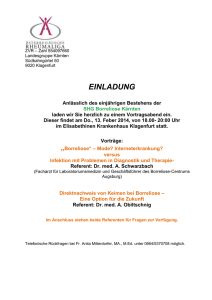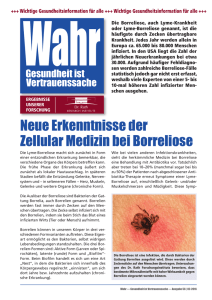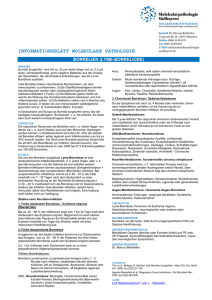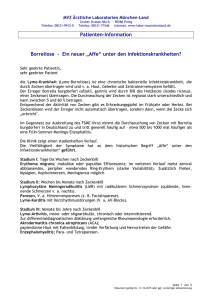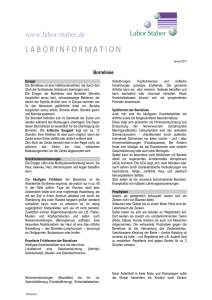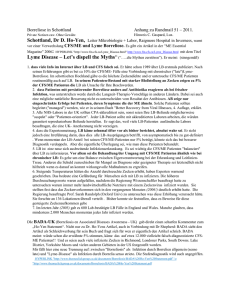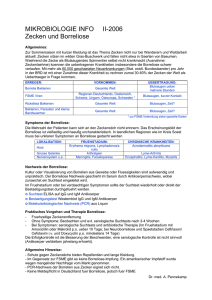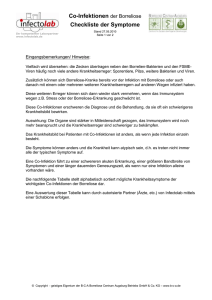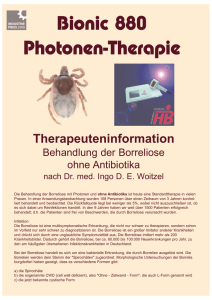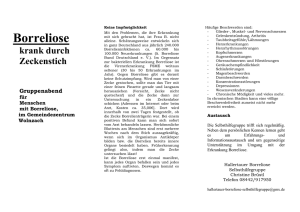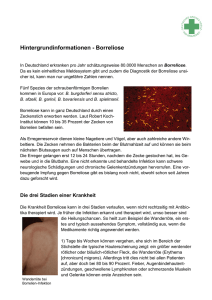(LTT- Borrelien) für die Diagnostik und - UMG
Werbung
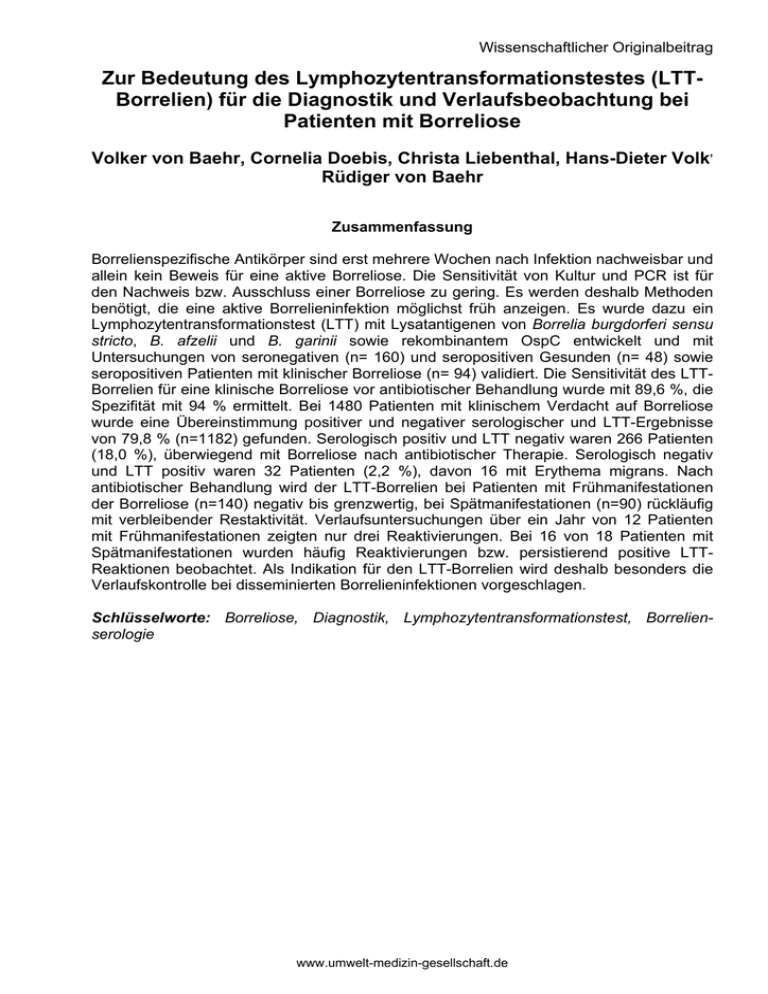
Wissenschaftlicher Originalbeitrag Zur Bedeutung des Lymphozytentransformationstestes (LTTBorrelien) für die Diagnostik und Verlaufsbeobachtung bei Patienten mit Borreliose Volker von Baehr, Cornelia Doebis, Christa Liebenthal, Hans-Dieter Volk, Rüdiger von Baehr Zusammenfassung Borrelienspezifische Antikörper sind erst mehrere Wochen nach Infektion nachweisbar und allein kein Beweis für eine aktive Borreliose. Die Sensitivität von Kultur und PCR ist für den Nachweis bzw. Ausschluss einer Borreliose zu gering. Es werden deshalb Methoden benötigt, die eine aktive Borrelieninfektion möglichst früh anzeigen. Es wurde dazu ein Lymphozytentransformationstest (LTT) mit Lysatantigenen von Borrelia burgdorferi sensu stricto, B. afzelii und B. garinii sowie rekombinantem OspC entwickelt und mit Untersuchungen von seronegativen (n= 160) und seropositiven Gesunden (n= 48) sowie seropositiven Patienten mit klinischer Borreliose (n= 94) validiert. Die Sensitivität des LTTBorrelien für eine klinische Borreliose vor antibiotischer Behandlung wurde mit 89,6 %, die Spezifität mit 94 % ermittelt. Bei 1480 Patienten mit klinischem Verdacht auf Borreliose wurde eine Übereinstimmung positiver und negativer serologischer und LTT-Ergebnisse von 79,8 % (n=1182) gefunden. Serologisch positiv und LTT negativ waren 266 Patienten (18,0 %), überwiegend mit Borreliose nach antibiotischer Therapie. Serologisch negativ und LTT positiv waren 32 Patienten (2,2 %), davon 16 mit Erythema migrans. Nach antibiotischer Behandlung wird der LTT-Borrelien bei Patienten mit Frühmanifestationen der Borreliose (n=140) negativ bis grenzwertig, bei Spätmanifestationen (n=90) rückläufig mit verbleibender Restaktivität. Verlaufsuntersuchungen über ein Jahr von 12 Patienten mit Frühmanifestationen zeigten nur drei Reaktivierungen. Bei 16 von 18 Patienten mit Spätmanifestationen wurden häufig Reaktivierungen bzw. persistierend positive LTTReaktionen beobachtet. Als Indikation für den LTT-Borrelien wird deshalb besonders die Verlaufskontrolle bei disseminierten Borrelieninfektionen vorgeschlagen. Schlüsselworte: Borreliose, Diagnostik, Lymphozytentransformationstest, Borrelienserologie www.umwelt-medizin-gesellschaft.de 2 Wissenschaftlicher Originalbeitrag Abstract Impact of lymphocyte proliferation test (LPT) for diagnostics and follow up in patients suffering from borreliosis Borrelia-specific antibodies are not detectable until several weeks after infection and when present alone are no proof of an active infection. The sensitivity of culture and PCR for the diagnosis or exclusion of Lyme borreliosis is too low. Therefore, a method is required that detects an active Borrelia infection as early as possible. For this purpose, a lymphocyte proliferation test (LPT) using 3 endogenous Borrelia antigens (Borrelia burgdorferi sensu stricto, Borrelia afzelii and Borrelia garinii) and recombinant OspC was developed and validated through investigations of seronegative (n=160) and seropositive (n=48) healthy individuals as well as of seropositive (n=94) patients with clinically manifested borreliosis. The sensitivity of the Borrelia-LPT in clinical borreliosis before antibiotic treatment was determined as 89,6 % while the specificity was 94%. In 1480 patients with a clinical suspicion diagnosis of borreliosis, positive and negative results from serology and LPT were compatible in 79,8 % (n=1182) of cases. 266 patients (18,0 %) were serologically positive and LPT-negative. These were mainly patients with borreliosis after antibiotic therapy. 32 patients (2,2%) had a negative serology and a positive result in the LPT, 16 of which had erythema migrans. Following antibiotic treatment, the LPT becomes negative or borderline in patients (n=140) with early manifestations of borreliosis, whereas in patients with late symptoms (n=90) it shows a regression while still remaining positive. Follow-up investigations over a period of one year showed three reactivation among 12 patients with early manifestations in contrast to 15 out of 18 patients with late symptomatology, that exhibited frequent episodes of reactivation and/or persistently positive LPT-reactions. Therefore, we propose the follow-up monitoring of disseminated borrelia infections as the main indication for the Borrelia-LPT. Key words: borreliosis, diagniostics, lymphocyte transformation test, borrelia serology umwelt medizin gesellschaft 2009; 22(3): 246-255 Autoren: Dr. med. Volker von Baehr, Dr. rer. nat. Cornelia Doebis, Prof. Dr. med. Rüdiger von Baehr (Korrespondenz), Institut für Medizinische Diagnostik, Abteilung Immunologie, Nicolaistrasse 22, 12247 Berlin, [email protected] MTA Christa Liebenthal, Prof. Dr. med. Hans-Dieter Volk, Humboldt-Universität-Berlin, Institut für medizinische Immunologie der Charité, Campus Mitte, Charitéplatz 1, 10117 Berlin www.umwelt-medizin-gesellschaft.de
